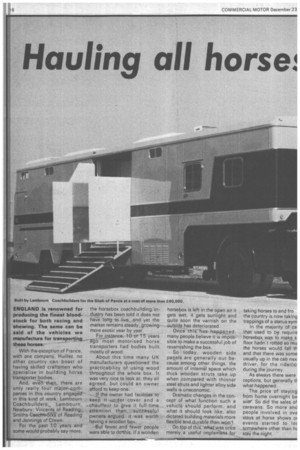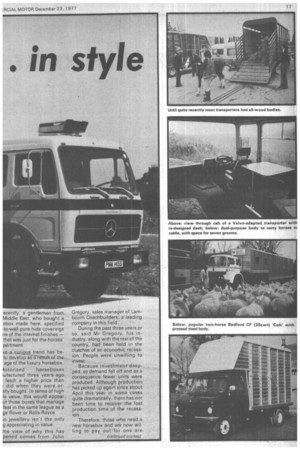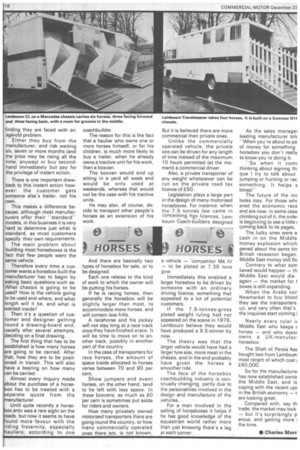horse!
Page 18

Page 19

Page 20

If you've noticed an error in this article please click here to report it so we can fix it.
ENGLAND is renowned to producing the finest bloodstock for both racing and showing. The same can b said of the vehicles we manufacture for transporting these horses, With the exception of Fra with one company, ilLiii;e7 00 that country can boast of eying skilled craftsmen who SPecialise in I:wilding horse ransponer bodies. And, ev'e'il then, there are only really four panics in in this country engage-d-in this kind of work: Lambourn Coachbuilders,„ Larnbourn, ,iMewbury; Vincents of Reading; Smiths Ceachw6iRS" of Reading a,nd Jennings of Crewe.
For the past 10 years some would probably say more, the horsehox coachbudding industry has been taid h does not have Tong to iive.. and yet the -narket remains steady gro‘mng more exotic, year by year.
For instance, 10 ot 15 years go must motorised horse ansperers had bodies built. ostiv of wood.
out this time many UK h-lanLtac.;.;_peis questioned the pracicab::,ty fi( us_rig wciod throughout the vvho',e uux It was very nice to look at, they all agreed, but could an owner afford to keep one.
,tthe owner had facilities to • keep tt Ainder cover and a --chauffeur to give it full-time attention then, successful owners argued, it was worth having a wooden box.
4lut fewer and fewer people were able to dolhis If a wooden
horsebox is left in the open air it gets wet, it gets sunlight and quite soon the varnish on the outside has deteriorated.
Once this has happened, many people believe it is impossible to make a successful job of revarnishing the box.
So today, wooden side panels are generally out because among other things, the amount of internal space which thick wooden struts take up when compared with thinner steel struts and lighter alloy side walls is uneconomic.
Dramatic changes in the concept of what function such a vehicle should perform, and what it should kook like, also dictated building materials more flexible and durable than wool.
On top of this, what was once merely a useful implement for taking horses to and fro , . he country is now Jak!ng
trappinosTof a status eym
In the iii00:161T9f ca that u se dlkilbV*tiLi ire horsebox was to make s floor hadn't rotted so mu the horses would fall th and that there was some usually up in the cab nex
• driveT, for the rider(s) during-the jourriey.
As always there were ceptions, but generally tf what happened.
The price of staying from hoMe overnight be soar-. So did the sales of Caravans. So .mare and people involved in ow: stays at horse shows 0 I event 9 started to lor somewhere other than hr stay the night. ecently, a gentleman from Middle East who bought a ebox made here. specified -to wall pure hide coverings ne,of the internal fir-list-les — that was just for the horses' pa rtment ut a curious trend has bet() develop as a--reSutt of the age of the luxury horsebox
loterised horseboxes
lufactured three years ago fetch a higher price than / did when they were or Ity bought In terms of high le value, this would appear ut those boxes that manage feat in the same league as a ge-Rover or Rolls-Royce.
;o jewellery iso the only g appreciating -in value.
r-ie view of why this has peried comes from John Gregory sales manager of 1_, an-1bourn Coachbuilders a leading company in .this field_ .
During the past three years or so,, said Mr Gregory his industry, along with the rest Of the country: had been held in the clutches of an economic recess. ion. People were unwilling to invest.
Because investment dropped, so demand fell of and as a consequence fewer units 'were produced. Although production has picked up again since about April this year in some cases quite dramatically, there has not been time to recover the lost production time of the rec.ession.
Therefore, those who need a new horsebox and are now wil ling to pay out for one are cur/trolled ovoleat
finding they are faced with an age-old problem.
Either they buy from the manufacturer, and risk waiting six, seven or more months (and the price may be rising all the time, anyway) or buy secondhand immediately but pay for the privilege of instant action.
There is one important drawback to this instant action however: the customer gets someone else's trailer, not his own.
This makes a difference because, although most manufacturers offer their "standard" models, in this business it is very hard to determine just what is standard, as most customers .specify their own requirements.
The main problem about building most horseboxes is the fact that few people want the same vehicle.
Therefore every time a customer wants a horsebox built the manufacturer has to begin by asking basic questions such as: What chassis is going to be .used? How is the vehicle going to be used and where, and what length will it be, and what is wanted inside?
Then it's a question of customer and designer getting round a drawing-board and, usually after several attempts, deciding on a final drawing.
The first thing that has to be established is how many horses are going to be carried. After that, how they are to be positioned in transit. This will also have a bearing on how many can be carried.
Almost every inquiry made about the purchase of a horsebox has to be treated with a separate quote from the manufacturer.
Until quite recently a horse [ox artic was a rare sight on the oads, but now it seems to have oUnd more favour with the iding fraternity, especially auliers, according to one ,
coachbuilder.
The reason for this is the fact that a haulier who owns one or more horses himself, or for his children, is much more likely to buy a trailer, when he already owns a tractive unit for his work, than a boxvan.
The boxvan would end up sitting in a yard all week and would be only used at weekends, whereas that would not be the case with his tractive units.
He may also, of course, decide to transport other people's horses as an extension of his work.
And there are basically two types of horsebox for sale, or to be designed.
Each one relates to the kind of work to which the owner will be putting his horses.
If he is racing horses, then generally the horsebox will be slightly larger than most, to accommodate more horses, and will contain less frills.
A racehorse and his jockey will not stay long at a race track once they have finished a race. It will be time to move on to another track, possibly in another part of the country.
In the case of transporters for race horses, the amount of space inside allocated to horses varies between 70 and 90 per cent.
Show jumpers and event horses, on the other hand, tend to be left with less space. In these boxvans, as much as 60 per cent is sometimes put aside for riders and owners.
How many privately owned mOtorised transporters there are going round the country, or how many commercially operated ones there are, is not known, But it is believed there are more commercial then private ones.
Unlike the commercially operated vehicle, the private one can be driven for any length of time instead of the maximum 10 hours permitted (at the moment) a commercial driver.
Also, a private transporter of any weight whatsoever can be run on the private road tax licence of £50.
Legislation plays a large part in the design of many motorised horseboxes. For instance, when the 7.5 tonnes law came in concerning hgv licences, Lambourn Coach-builders designed a vehicle — 'competitor Mk IV — to be plated at 7.38 tons gvw.
Immediately this enabled a larger horsebox to be driven by someone with an ordinary driving licence, something that appealed to a lot of potential customers.
If the 7.5-tonnes-gross plated weight ruling had not appeared on the scene in 1976, Lambourn believe they would have produced a 9.5-tanner by now.
The theory was that the larger vehicle would have had a larger tyre size, more meat in the chassis, and in the end probably have given the horses a smoother ride.
The face of the horsebox coachbuilding industry is continually changing, partly due to the personalities involved in the design and manufacture of the vehicles.
For a man involved. in the selling of horseboxes it helps if he has good knowledge of the equestrian world rather more than just knowing there's a leg at each corner.
As the sales manage' leading manufacturer tolc "When'you're about to pa of money for something horsebox you don't really to know you're doing it.
"So when it corn( thinking about signing th, que I try to talk about jumping or hunting or rae something. It helps s times!"
The future of the inc looks rosy. For those whc ered the economic rece and are now, in some case climbing out of it, the ordei is beginning to see a little coming back to its pages.
The lucky ones were a cash in on the Middle 'money explosion which pened about the same tin British recession began. Middle East money still flo Contrary to what som lieved would happen — th Middle East would die again — the market for I boxes is still expanding.
When the Arabs cor Newmarket to buy blood they see the transporters up, and very often that's the inquiries start coming i Nearly every ruler it Middle East who keeps r horses — and who doesr owns a UK-manufac• horsebox.
The Shah of Persia has. bought two from La mbourri most recent of which cost £40,000.
So for the manufacture' has now established coma the Middle East, and is coping with the recent up: in the British economy — t are looking great.
Compared with, say th trade, the market may look — but it's surprisingly p erous, and getting more : the time.
• Charles Mom




































































